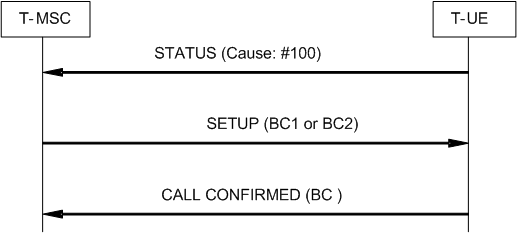Content for TS 23.172 Word version: 18.0.0
1…
4…
4.2.2…
4.2.3
4.2.4
4.2.5…
4.2.5.2
4.3…
4.3.2…
4.3.3…
4.3.3.1.3
4.3.3.1.4
4.3.3.1a…
4.3.4
4.3.5…
4.3.5.2
4.3.6…
4.2.2 Mobile terminating side p. 10
When the terminating MSC receives a request for a multimedia call, it shall check if the called user is provisioned for the service (see subclause 4.2.2.1).
The terminating MSC shall include in the SETUP message towards the UE both BC-IEs in the same order as indicated by the incoming request together with the Repeat Indicator set to "service change and fallback" in order to invoke the SCUDIF functionality in the called terminal (see Figure 4.5).
The terminating UE, based on its capabilities and internal settings, may return the two BC-IEs in the same order (to indicate that it accepts the proposed settings - see Figure 4.6), reversed order (see Figure 4.7), or just one BC-IE (either speech or multimedia - see Figure 4.8) to the terminating MSC in the CALL CONFIRMED message. If the terminal supports Network-initiated service upgrade to multimedia, then it shall also indicate this in the CALL CONFIRMED message with the"Enhanced Network-initiated ICM" (ENICM) Capability (see TS 24.008).
In the case the UE ignores the SETUP message due to the presence of a reserved value for the Repeat Indicator, it sends a STATUS message back to the terminating MSC (see Figure 4.9), with the Cause Value set to #100, "Conditional IE error" (see clause 8.7.2 of TS 24.008). The terminating MSC shall then react according to clause 5.5.3.2.2 of TS 24.008, and it shall send a new SETUP message with a single BC, either the preferred service BC-IE or the speech BC-IE (fallback to speech), depending on configuration. The call setup then proceeds accordingly.





4.2.2.1 Subscription checking p. 11
The functional behaviour of the terminating MSC and VLR is specified in TS 23.018. The procedure specific to SCUDIF calls is specified in this subclause.
For mobile terminating SCUDIF calls, the MSC shall convert the services received in the incoming request to two individual Basic Service codes, and include them in Send Info For Incoming Call. The VLR shall check the subscription for those basic services, then indicate the availability of each basic service to the MSC by Complete Call. If both services are not provisioned, the VLR shall send Send Info for Incoming Call negative response to the MSC. The MSC shall fall back to the allowed service if the availability of only one service is indicated. The MSC shall continue as a SCUDIF call if the availability of both services is indicated.
4.2.2.1.1 Send Info For Incoming Call p. 11
Send Info For Incoming Call contains the following SCUDIF specific information elements:
| Information element name | Status | Description |
|---|---|---|
| Bearer Service 2 | C | Bearer Service 2 required for the MT call, derived from the less preferred service indicated in the incoming IAM of a SCUDIF call. For a SCUDIF call, one of Bearer service 2 or Teleservice 2 shall be present. |
| Teleservice 2 | C | Teleservice 2 required for the MT call, derived from the less preferred service indicated in the incoming IAM of a SCUDIF call. For a SCUDIF call, one of Bearer service 2 or Teleservice 2 shall be present. |
4.2.2.1.2 Complete Call p. 12
The parameters described in subclause 4.2.1.1.2 "Complete Call" for the mobile originating MSC are also applicable to the mobile terminating MSC.